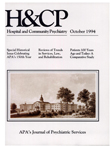A Psychiatric Hospital 100 Years Ago: I. A Comparative Study of Treatment Outcomes Then and Now
Abstract
Objective: The authors'goal was to compare distribution of diagnoses, length of stay, and read mission rates for every 16th patient admitted to the St. Louis County Insane Asylum (now St. Louis State Hospital) between 1886 and 1904 with those for every 16th patient admitted to the hospital between 1978 and 1980. Methods: A sample of 369 cases was drawn from the archival admission records, and 380 cases were selected from recent admissions. Descriptive data from the archival records were used to make DSM-III diagnoses. Data on length of stay and number of readmissions were collected from case records. Results: The historical sample had fewer cases of major mental illness, longer mean lengths of stay, and fewer mean readmissions than the modern sample. Conclusions: Differences in the clinical characteristics of the two samples may be explained by differences between the two periods in treatment philosophies, admitting policies, and presence of alternative resources for accommodating long-term chronic patients.
Access content
To read the fulltext, please use one of the options below to sign in or purchase access.- Personal login
- Institutional Login
- Sign in via OpenAthens
- Register for access
-
Please login/register if you wish to pair your device and check access availability.
Not a subscriber?
PsychiatryOnline subscription options offer access to the DSM-5 library, books, journals, CME, and patient resources. This all-in-one virtual library provides psychiatrists and mental health professionals with key resources for diagnosis, treatment, research, and professional development.
Need more help? PsychiatryOnline Customer Service may be reached by emailing [email protected] or by calling 800-368-5777 (in the U.S.) or 703-907-7322 (outside the U.S.).



